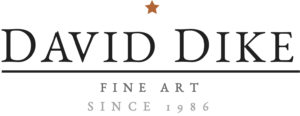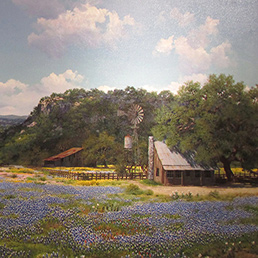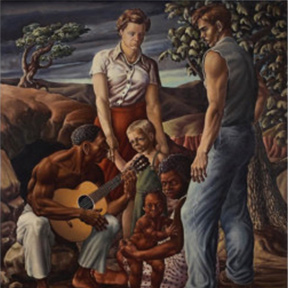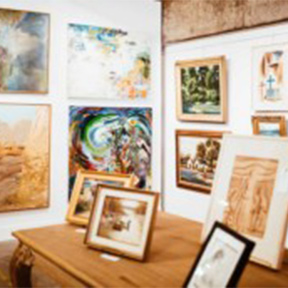- (214) 720-4044
- info@daviddike.com
- Mon - Fri: 10 am - 5 pm
Dixon, Maynard
Maynard Dixon
(Am. 1875-1946)
Born in Fresno, California in the San Joaquin Valley, Maynard Dixon, originally named Henry St. John Dixon, became a noted illustrator, landscape, and mural painter of the early 20th-century American West, especially the desert, Indians, early settlers, and cowboys.
Several phases of Dixon’s career show him to be an early modernist painter who incorporated Post-Impressionism and Cubist-Realism into his landscapes and skyscapes. Examples of strong modernist influences in his paintings are “Cloud World” of 1925 and “Study in Cubist Realism”, 1925. His career can be divided into several periods: 1890-1905, Self taught; 1905-1915, Illustrator; 1915-1921, Post Impressionist; 1921-1930, Cubist Realist; and 1930-1946 Simple Modern Confidence!
According to Paul Bingham, Director of the Thunderbird Foundation former home of the artist that now houses the primarly collection of Dixon’s paintings, “these two last periods between 1921 and 1946 make the strongest modern statement.”
Maynard Dixon lived most of his life in the West, living at times in Mount Carmel, Utah; Tucson, Arizona; and the desert of California near Mecca and Indio. His close friends were artists Jimmy Swinnerton, John Hilton, and Clyde Forsythe. He settled in California and adopted the sun-drenched pallete of the California school. His last years he suffered horribly from asthma.
He was from a family of Virginia emigrants whose lineage was tied to English aristocracy. Living part of his youth in Colorado, Dixon made drawings of western life from the time he was seven years old. A sickly youngster whose activity had to be restricted, Dixon was inspired by illustrators, especially Remington, with whom he got in touch and who gave him positive critiques of his work.
In 1893, he moved with his family to Alameda, and that same year, his first illustration was published and was in Overland Monthly.
He briefly attended the Mark Hopkins Art Institute where he learned art fundamentals, but discontent with academics, he left after three months, deciding to travel and paint from nature. He took his first full-time job in 1895, becoming an illustrator for the San Francisco Morning Call and four years later he joined the San Francisco Examiner. He also wandered and sketched all over the West and Northwest—Colorado, Arizona, New Mexico, and Utah and exhibited regularly with the San Francisco Art Association.
In 1905, Dixon married artist Lillian West Tobey, and the next year his studio with most of his early work was destroyed by the San Francisco earthquake and fire. He and his wife moved to Sausalito.
One of the first critics to laud him was Charles Lummis, first city editor of the Los Angeles Times, and well known writer who crusaded for western settlement. At the encouragement of Lummis, Dixon had first visited Arizona in 1900 and 1902, and seeing that state, Dixon proclaimed “he had found his country.”
He visited Hubbell’s Trading Post and painted the Navajo Indians at Canyon de Chelly on a commission from Hubbell. He returned to Arizona again and again including in 1907 to Tucson where he did a series of western murals for the newly-built Southern Pacific Railroad Depot.
From 1907 to 1912, Dixon studied and illustrated with Century, Scribner’s, and Mc Clure’s magazines in New York and earned honors including membership in the Salmagundi Club and National Academy of Design.
During this time of living in the East, he received in 1909 an invitation to travel northwest from an admirer of his work, Charles Moody, and from this experience spent time in Coeur D’Alene, Idaho, and in Cutbank, Montana. There he worked as a cowboy for the C Cattle Company, punching cows and living with wranglers and studying Indians and western life generally. He sketched about one-hundred fifty cowboys and landscape of the one-hundred square miles that they roamed.
In 1912, he returned to California, and gave up commercial art for mural and easel painting. In 1915, during the Panama Pacific Exposition, he had a nervous breakdown, and two years later divorced his wife. In 1920, he married Dorothea Lange, a photographer, and this marriage lasted until 1935.
In 1937, he married Edith Hamlin, an artist, and they purchased property in 1939 at Mount Carmel, Utah and built their home and studio there. It was their intention to invite artists from around the country to come to create fine art and enjoy the ambience and spirit of the area. That is now the mission of the Thunderbird Foundation for the Arts, located on the same property. However, Dixon was unable to spend much time at Mount Carmel because he needed a drier climate for his health, so he and his wife lived primarily in Tucson, Arizona, where he died on November 14, 1946.
Dixon’s style was painting bold masses of color with simplicity of line, a technique that led him into mural painting in which he excelled much of his professional life. In Los Angeles, he also did murals for the new Southwest Museum founded by Charles Lummis, and in 1946, he did sketches for a large mural of the Grand Canyon for the Santa Fe Railway’s Los Angeles office. But he died before he completed the work, and his widow, Edith Hamlin and his friend Buck Weaver finished it.
Source: Donald Hagerty, Desert Dreams: The Art and Life of Maynard Dixon Edan Hughes, Artists in California, 1786-1940 James Ballinger, Visitors to Arizona, 1846 to 1980 Paul Bingham, Director, Thunderbird Foundation
Maynard Dixon (Am. 1875-1946) | Trails of a Bronco Bust, 1901 | graphite on paper 10 3/8 x 9 1/2
Maynard Dixon (Am. 1875-1946) | Desert Range, Nevada | graphite on paper 7 3/4 x 10 1/4
Maynard Dixon (Am. 1875-1946) | The Desert | pen and ink on paper 12 x 10 | signed lower left: The Desert & on reverse by Mrs. Edith Hamlin Dixon
Maynard Dixon (Am. 1875-1946) | California Vacquero, 1900 | graphite on paper | 8 1/2 x 11 | signed lower left: MD
Maynard Dixon (Am. 1875-1946) | The Pawnee 1945 | conte crayon, chalk and graphite on paper 16 1/4 x 19 3/4 | signed lower right: Maynard Dixon 45
Maynard Dixon (Am. 1875-1946) | Untitled - Indian Brave | pen, ink and opaque white on paper | 13 1/8 x 10 3/4 | signed lower left: 1904





